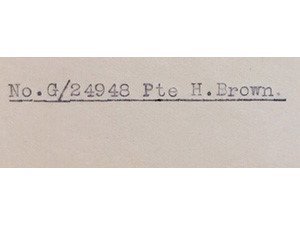 October is Black History Month, an opportunity to celebrate the invaluable contributions of Black people to British society. Surrey Heritage supports this international awareness campaign every year. As part of our ongoing development work to ensure that all communities are represented in Surrey's historic archive collections, we recognise the need to preserve the history of Black lives in the county, raising awareness of their lived experience. This work can also help inspire and empower future generations.
October is Black History Month, an opportunity to celebrate the invaluable contributions of Black people to British society. Surrey Heritage supports this international awareness campaign every year. As part of our ongoing development work to ensure that all communities are represented in Surrey's historic archive collections, we recognise the need to preserve the history of Black lives in the county, raising awareness of their lived experience. This work can also help inspire and empower future generations.
You can access our online 'Black History in Surrey' resource on our Exploring Surrey's Past website. The Black History Month website features articles and commentary on all areas of research from African and pre-colonial history and slavery, to sporting heroes and inspirational people.
This year's theme for Black History Month is 'Reclaiming Narratives' and marks a significant shift towards recognising and correcting the narratives of Black history and culture. By emphasising 'Reclaiming Narratives', we shine a brighter light on our stories, allegories, and history. This theme underscores a commitment to correcting historical inaccuracies and showcasing the untold success stories and the full complexity of Black heritage.
Our unique archive and library collections reveal important local life stories, with context. To twenty first century eyes these can sometimes be challenging to read but as archivists we do not obscure the historical record, positive or negative, and we fully acknowledge how people of colour were treated in the past and the reasons behind this. However, the survival of first-hand personal testimonies of any marginalised community to help spotlight lived experience and provide balance in the narrative can be extremely hard to come by.
In this Marvel we look at the narratives of two local Black History stories with different origins and show how our archive collections help amplify them to reveal the bigger picture.
John Springfield – the importance of family testimony
 The story of John Springfield's life and his time in Surrey is a rare case of how handed-down family legend and archive sources come together to provide details of an extraordinary life. Surrey has often been viewed as not being a diverse county but Black people have lived here for hundreds of years and whilst their stories may not be well-known they have left a record in our archive collections which show there has been a presence since the sixteenth century.
The story of John Springfield's life and his time in Surrey is a rare case of how handed-down family legend and archive sources come together to provide details of an extraordinary life. Surrey has often been viewed as not being a diverse county but Black people have lived here for hundreds of years and whilst their stories may not be well-known they have left a record in our archive collections which show there has been a presence since the sixteenth century.
John Springfield was born around 1847 in Zanzibar (formerly a British Protectorate but now an independent republic merged with Tanganyika). He was allegedly the son of a chief, named Jumbalowagee or Jumbaloowagee, but the name by which he was known in Zanzibar remains unknown. His naval service documents give us exact dates and details about his career at sea aboard HMS Victoria, and the usual genealogy sources, such as census returns and civil registration certificates, tell us when and where he lived. However, they tell us little about the man himself and there are many gaps in his complex story.
 There is, however, one important source for John's story: oral history was handed down from his wife, Eliza, to their daughter Miriam, and then to granddaughter, Zillah (born 1897). Zillah told her grandfather's story to the Surrey Advertiser, and it was published on 25th January 1985 (reference 1714/10). This story involves John being kidnapped at the age of nine by Portuguese sailors and left for dead, being rescued by Dr David Livingstone, preaching anti-slavery in America and eventually settling in Guildford in the 1870s where he worked as a cobbler. We also learn from Zillah that Eliza worked at Abbot's Hospital and Miriam attended Miss Bloxham's School in Guildford, but was bullied for the colour of her skin.
There is, however, one important source for John's story: oral history was handed down from his wife, Eliza, to their daughter Miriam, and then to granddaughter, Zillah (born 1897). Zillah told her grandfather's story to the Surrey Advertiser, and it was published on 25th January 1985 (reference 1714/10). This story involves John being kidnapped at the age of nine by Portuguese sailors and left for dead, being rescued by Dr David Livingstone, preaching anti-slavery in America and eventually settling in Guildford in the 1870s where he worked as a cobbler. We also learn from Zillah that Eliza worked at Abbot's Hospital and Miriam attended Miss Bloxham's School in Guildford, but was bullied for the colour of her skin.
Whilst we must address potential inaccuracies in a secondary source such a newspaper report, we must also acknowledge the value of oral history, and among many communities it is the means by which their history and culture is passed down to generations. Not all cultures have a tradition of written record-keeping and, in John Springfield's case, the family's oral testimony is a crucial part of evidencing his life. You can read John's full story on our Exploring Surrey's Past website. It's important to acknowledge that family stories can be embellished over time or information skewed as it is passed down from generation to generation so we've tried to research as much as we possibly can about John's life, contacting archive organisations around the world. However, some areas have proved impossible to evidence so if you can add any information we'd be delighted to hear from you, please contact us at shs@surreycc.gov.uk.
Harold Brown – an invisible 'Black Poppy'
 Throughout the First World War thousands of Black Britons made a vital contribution by serving in all branches of the armed forces. They were joined by recruits from the West Indian colonies, African colonies and Black South Africans. However, apart from Walter Tull, the professional footballer, their stories were largely not heard compounding the narrative that the efforts of Black servicemen and auxiliaries were unimportant. However, following the centenary of the war, agencies such as Black History Month and the Imperial War Museum created excellent online resources focused on Black recruits who served the Empire.
Throughout the First World War thousands of Black Britons made a vital contribution by serving in all branches of the armed forces. They were joined by recruits from the West Indian colonies, African colonies and Black South Africans. However, apart from Walter Tull, the professional footballer, their stories were largely not heard compounding the narrative that the efforts of Black servicemen and auxiliaries were unimportant. However, following the centenary of the war, agencies such as Black History Month and the Imperial War Museum created excellent online resources focused on Black recruits who served the Empire.
Stephen Bourne's 'Black Poppies – Britain's Black Community and the Great War' (The History Press, 2014) featured more untold stories, including that of Harold Brown, the son of a West Indian seaman, and his wife Elizabeth Emma (née Cross), a white Londoner, who served as a private in the 3/4th battalion Queen's Royal West Surrey Regiment. Brown had been featured in the Imperial War Museum's 2008 exhibition 'From War to Windrush' but using material in our regimental collections and elsewhere we took a closer look at Harold Brown's war contribution. You rarely hear anything about Black soldiers receiving commendations but not only did Brown serve he was also awarded two Certificates of Gallantry, one for helping to capture a German concrete fortress in Ypres. The battalion war dairy states that he "set a fine example of physical endurance carrying on throughout the whole of October 4th although severely wounded at the outset". Furthermore, Brown was awarded the Military Medal, in December 1919, whilst based in Auberchicourt, northern France. Memoirs of Black soldiers are rare, and we can only wonder whether he served with others, or if any other Black soldiers in the Surrey regiments received Gallantry awards or bravery medals?
 Our full research about Harold Brown can be seen on our Exploring Surrey's Past website. Again, if anyone can add information, please contact us.
Our full research about Harold Brown can be seen on our Exploring Surrey's Past website. Again, if anyone can add information, please contact us.
Objectively cataloguing our records is vital, and the research we carry out can help us acknowledge bias and the reasons why some narratives have been lost, obscured or changed completely. Decolonising our collections is a huge but necessary task for archives such as ours and this could well be a subject for a future Marvel.
Images
Select image to view a larger version.
- Portrait photograph of John Springfield, circa 1880s (reference 1714/1)
- Copy photograph of Zillah Puttock (née Twort), granddaughter of John Springfield, 1914 (reference 1714/7)
- Private Harold Brown, wearing the uniform of the Queen's Royal West Surrey Regiment (QRWS), with a colleague, undated [circa 1915] (courtesy of the Imperial War Museum (IWM), reference MISC 2816-5579-5)
- Entry from the war diary of 3/4th Battalion QRWS Regiment citing Harold Brown's Card of Honour, 8 October 1917 (reference QRWS/7/1)

